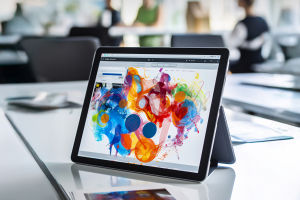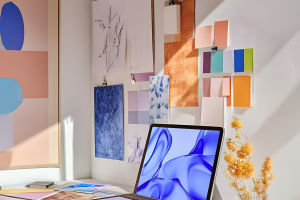Art has long been celebrated not just for its aesthetic value but for its profound impact on the human psyche.
Whether hanging in a gallery, displayed on a screen, or simply admired in passing, art has the unique ability to evoke emotions, stir memories, and challenge perceptions. But what happens in the mind when we view art?
Why does a painting, sculpture, or photograph sometimes leave us feeling moved or disturbed? This article explores the psychological effects of viewing art, exploring how it influences our mood, cognition, and overall mental well-being.
The Emotional Response to Art
The immediate and most obvious effect of viewing art is the emotional reaction it provokes. Different pieces of art can evoke a wide range of emotions—joy, sadness, nostalgia, anger, or even confusion. The emotional response to art is largely influenced by the subject matter, colors, shapes, and composition, but it is also deeply personal. The viewer's own experiences, cultural background, and mood can heavily influence how they interpret a piece of art.
• Art and Happiness: Viewing positive or uplifting artwork, such as bright landscapes or joyful portraits, often triggers feelings of happiness and well-being. For example, studies have shown that nature-based art, like landscapes, can reduce stress and increase feelings of peace and happiness. Bright, warm colors like yellow and orange tend to stimulate emotions of optimism and cheer.
• Art and Sadness: On the other hand, art that depicts tragic or melancholic themes can invoke a sense of sadness or introspection. Darker color palettes, somber tones, and themes of loss or isolation often resonate with viewers who are experiencing similar emotions in their own lives. This connection to emotion can foster a sense of catharsis, allowing viewers to process their own grief or vulnerability.
• Art and Anxiety: Some pieces of art, particularly abstract or fragmented works, can evoke feelings of unease or anxiety. The use of sharp contrasts, distorted shapes, or chaotic compositions may trigger a sense of discomfort. These types of works often push the viewer out of their comfort zone, confronting them with unsettling images or thoughts.
Art and Cognitive Function
While the emotional effects of art are widely acknowledged, its impact on cognitive function is equally significant. The act of interpreting and engaging with a piece of art requires attention, perception, and critical thinking. This intellectual engagement can sharpen cognitive skills, improve focus, and enhance problem-solving abilities.
• Increased Cognitive Flexibility: Viewing art encourages the brain to interpret and process visual information in multiple ways. This helps increase cognitive flexibility—the ability to consider multiple perspectives and adapt to changing information. People who frequently engage with complex art forms, such as abstract or surrealist art, often show greater ability to handle ambiguity and think creatively in other aspects of life.
• Boosting Memory: Exposure to art can also improve memory retention. Studies have found that individuals who visit art galleries and museums show higher cognitive function, including improved recall of specific details. Art's ability to captivate attention allows for better encoding of information, making it easier to remember related facts or experiences.
• Engagement with Art and Learning: Art is a valuable tool for education because it promotes active learning and critical thinking. Whether in a museum setting or during personal exploration, art encourages individuals to question, interpret, and analyze the world around them. This process not only increases awareness of social and cultural issues but also fosters a deeper understanding of history and humanity.
Art's Impact on Mental Health and Healing
In addition to its cognitive benefits, art has been shown to have a therapeutic effect on mental health. Art therapy, a widely practiced form of therapy, involves the use of creative expression as a tool for healing. This practice harnesses the power of art to help individuals process trauma, manage emotions, and overcome mental health challenges.
• Reducing Stress and Anxiety: Engaging with art can lower levels of cortisol, the hormone associated with stress. The act of viewing art allows the viewer to enter a state of relaxation, similar to meditation. Art can serve as a form of escapism, providing a break from the pressures of daily life. It has been shown to lower heart rates and promote a sense of calm and tranquility, especially when the artwork evokes peaceful imagery or harmonious compositions.
• Emotional Expression and Catharsis: Art allows individuals to express feelings that may be difficult to articulate with words. For those dealing with trauma or emotional pain, creating or observing art can facilitate catharsis—an emotional release that leads to healing. Art therapy, particularly, provides an outlet for repressed emotions and helps individuals process complex feelings of grief, anger, and loss.
• Improving Self-Esteem: Engaging with art, either through creation or observation, can foster a sense of accomplishment and self-worth. The process of making art allows individuals to create something tangible and meaningful, promoting feelings of pride and self-efficacy. For those struggling with mental health issues, art can provide a sense of control and achievement in a world that may feel unpredictable.
The Role of Art in Social Connection
Art also plays a key role in promoting social connection and empathy. Art has the power to bring people together, whether it's in a communal gallery space or a collaborative art project. Through art, individuals can share their personal experiences, foster dialogue, and build empathy for others.
• Creating Empathy and Understanding: Viewing art that represents different cultures, social issues, or personal struggles can increase empathy and understanding. Art has the unique ability to humanize complex issues, allowing viewers to connect emotionally with perspectives outside of their own. By engaging with diverse forms of art, individuals develop a deeper understanding of global challenges.
• Social Bonding Through Art: Shared experiences of art, such as attending gallery exhibitions or discussing art with others, can create meaningful social bonds. Art has the ability to unite people with different backgrounds and perspectives, providing a platform for conversation, learning, and growth.
The Deep Connection Between Art and the Mind
Art is far more than a form of aesthetic expression—it is a powerful psychological tool that influences our emotions, thoughts, and social connections. The psychological effects of viewing art are profound and multifaceted, impacting everything from cognitive function to emotional well-being. Whether it's evoking joy, providing solace, or promoting critical thinking, art has the ability to shape our minds in ways that are both subtle and significant.
As we continue to explore the intricate relationship between art and psychology, it is clear that the act of engaging with art is not just a visual experience—it is a deeply transformative journey for the mind and soul.


